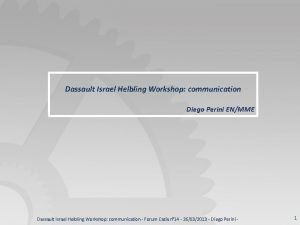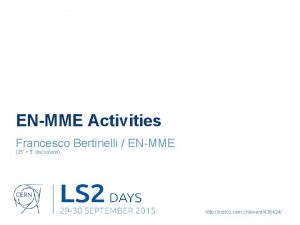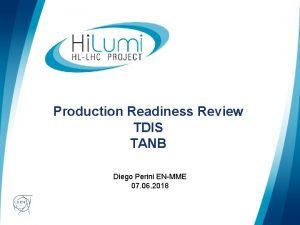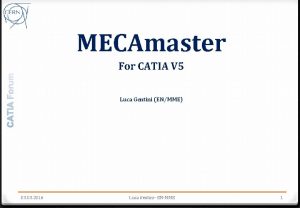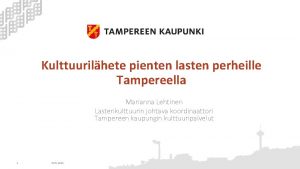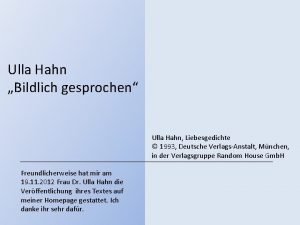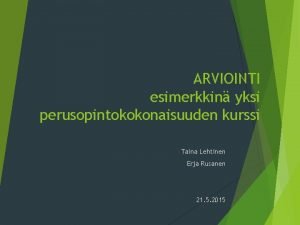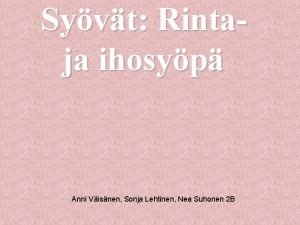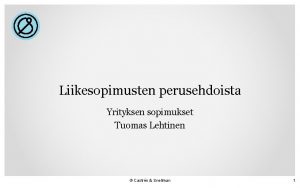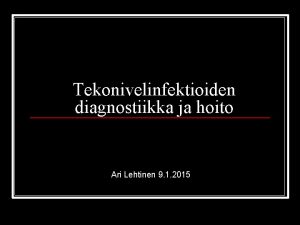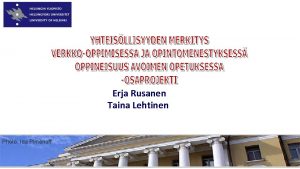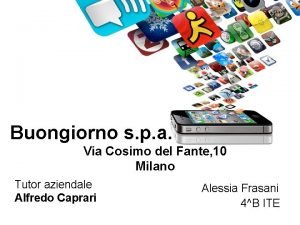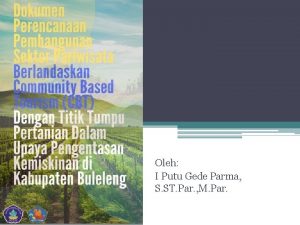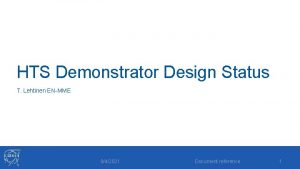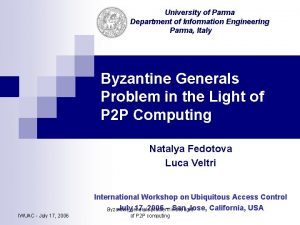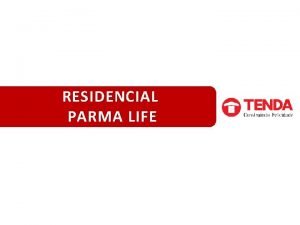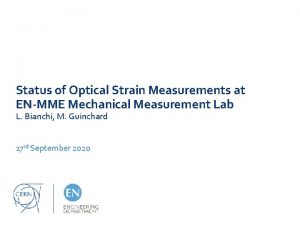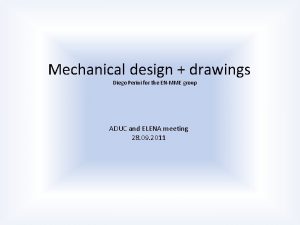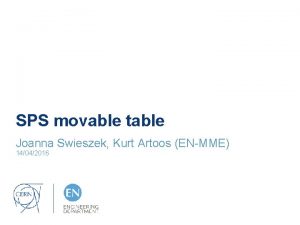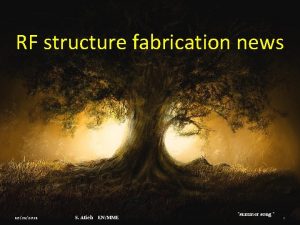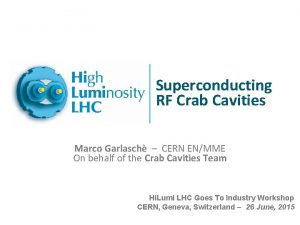Anticryostats Status Report T Lehtinen ENMME V Parma















- Slides: 15

Anti-cryostats Status Report T. Lehtinen (EN-MME), V. Parma, M. Strychalski (TE-MSC/CMI) WP 03 meeting, 4 November 2020

Contents § Introduction § Prototype AC for MQXFP 1 § Summary and next steps 2

Introduction Scope: § HL LHC magnets need new sets of anti-cryostats for horizontal magnetic measurements in SM 18 § Larger cold bores and variety in lengths require new designs § Compatibility, as far as possible, with existing equipment Work organization and sharing: § TE-MSC/CMI leads the project of the AC under WP 03 (M. Strychalski, V. Parma) § Design and construction done in a joint collaboration with EN-MME: § § § Mechanical engineering and electrical heaters design: T. Lehtinen (EN-MME) Electrical heaters supplied by EN-MME via EP-DT (R. De Oliveira) Mechanical assembly by EN-MME (P. Moyret et al. ) Assembly of electrical heater and instrumentation by EN-MME (M. Guinchard et al. ) Assembly of MLI and support to mechanical assembly by MSC-CMI (SMI 2 technicians) TE-MSC/CMI remains in charge for thermal design aspects and design and supply of bellows (Y. Leclercq) § TE-MSC/TF is in charge of developing the temperature control system and logics (power supplies, PID controls) 3

Design features prototype AC remains in CFB inserted in cryo-magnet T. Lehtinen, EN-MME 4

0 7 Situation Extension CFB / 0 1 / Romain Ferriere / Robin Betemps – 02/11/2020 2 2 pour Q 1/Q 2/Q 3 & CP / D 1 & D 2 Ongoing work n ~1 m extensio 5

AC families Cold bore dimensions Cold mass Q 1/Q 3 No of AC units Name LHCLMQXFA 0001 Type ID/thickness Length (flange to flange) 136. 7/4 10120 Long section Family 1 s d e Ne ting a d up Q 2 (long) MQXFB 01 136. 7/4 9905 Family 1 Q 2 proto 1 and 2 (short) MQXFBP 1/2 136. 7/4 8328 Family 2 CP MCBXFAP 1 136. 7/4 6916 Family 2 D 1 MBXFP 1 136. 7/4 8110 Family 2 D 2 MBRDP 1 94/3 13823 Family 3 § Possible change, 1 more family Short section (CFB) 2 (+1 spare) 3 (+1 spare) or 2 (+1 spare) 1 (+1 spare) 2 (+1 spare) Family 1 Q 1/3 Q 2 a Q 2 b Family 2 (for protos) Q 2 protos Family 3 CP D 1 Family 4 D 2 2 (+2 spares) 6

Assembly of the AC 7

Insertion of the AC in the Q 2 and CFB Q 2 AC before MRB closure Q 2 AC seen from the CFB side 8

Heat load measurements Objective Evaluate the heat load to the magnet by measuring power absorbed at warm in steady state Test conditions § Anti-cryostat under vacuum to remove any convection § Magnet at constant temperature (4. 5 K or 1. 9 K) § Electrical heaters controlled to maintain constant temperature Test/Measurement Measure power injected to electrical heater to maintain constant temperature of anti-cryostat wall 7 T gauges on magnet AC 2 T gauges on short AC A. Vande Craen, MSC-CMI 9

Magnet AC test results § § § Measured (electrical) heat load: 10. 0 +/- 1. 2 W (2 x 5. 0 W) ~ 0. 9 W/m Calculated thermal HL of the AC: < 3. 2 W/m By design the AC heaters were specified for up to 4 W/m 30, 00 10, 00 25, 00 9, 00 20, 00 8, 00 15, 00 7, 00 10, 00 6, 00 5, 00 07 -31 12: 00 Power injected [W] AC Temperature [°C] Long anti-cryostat (magnet) 4, 00 08 -01 00: 00 Temp_L 1 Temp_L 7 08 -01 12: 00 Temp_L 3 08 -02 00: 00 08 -02 12: 00 08 -03 00: 00 Temp_L 4 Temp_L 5 Temp_L 6 Average Power_P 3 A. Vande Craen, MSC-CMI 10

Improvements for HL-LHC Anti-cryostats Component Issue and improvement Thermal screen Cost, weight, difficult disassembly half-shell solution PCB heaters Cost, and long lead time, difficult to bond (long one) shorter single PCB Translation stops Mechanically weak (difficult tolerancing), cost, difficult to install and secure new design Polyimide supports Cost, possibly too weak improvements in design and material selection External support system Some interface issues on CFB/MRB modifications implemented End flange geometry for welding Risk of thermal deformation improved design Bellow connecting piece to inner tube Complexity improved design ? Helicoflex flanges Virtual volume due to weld scheme modified design Most improvements already implemented in 3 D models. 11

Improvements for HL-LHC Anti-cryostats - Thermal screen Previous solution: - Screen made out of two rolled half-shells - Interconnecting ring to join the half-shells, and center and support against the inner tube Measurements of the effect of such geometry on magnetic permeability will be carried out later this year 12

Improvements for HL-LHC Anti-cryostats PCB heaters Some points of the new design: - Two circuits both covering the full 360 degree circumference providing redundancy Shorter circuits (2. 4 m) to be joined to form longer ones, modularity If one circuit fails for any reason, the power can be increased on the remaining one to cover for the lost circuit. Cheaper to manufacture Easier to install 13

Summary and next steps § The prototype AC was successfully realized and tested on the prototype MQXFB § The mechanical and thermal performance, including temperature control, was experimentally validated confirming the design choices made § The PCB-type heater, a first for this type of application, provided very good results confirming the choice for the future AC § Improvements in the design are being implemented essentially to improve some mechanical aspects and reduce costs § Finalizing the design of the AC (and the AC families) depends on the ongoing design modifications of the CFB (extension) § Q 2 is now the priority, so the AC need to be ready for the test of Q 2 in June 21 § Our goal is to have the 2 AC (Q 2 AC and CFB AC) ready by April ’ 21 so the design must be finalized by the end of the year § The AC for the D 2 follow in terms of priority and will be a smaller re-scaled version for the DN 94 twin aperture cold bores 14

Thank you ! 15

